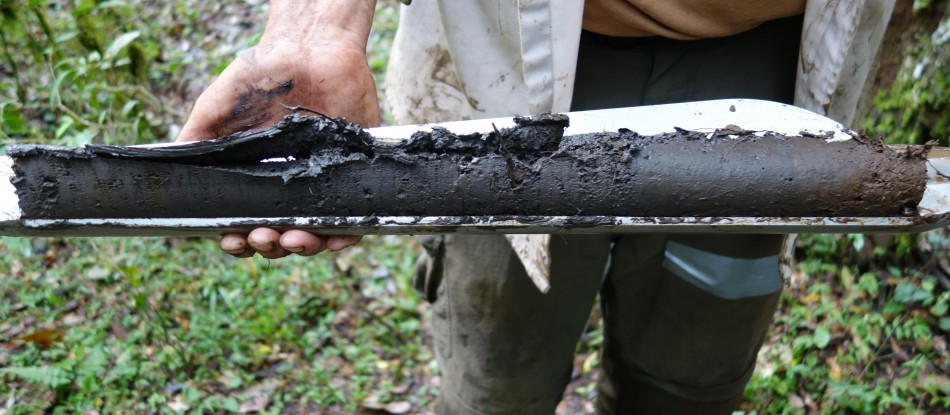
Palaeoecology of Jê Landscapes
Palaeoecology:
What is it?
Palaeoecology is the study of microscopic remains of organisms (e.g. fossil pollen and charcoal) from lake and bog sediments to reconstruct the long-term, millennial-scale, history of ecosystems, in the context of natural (e.g. climate) and anthropogenic disturbance.
How does it work?
In our Jê project we analyse pollen as a proxy for vegetation and charcoal as a proxy for fire. Plants produce vast quantities of pollen which enter into basins such as lakes or bogs, either by aerial input or via inflowing streams, where they are well preserved for millennia due to the oxygen-poor and/or acidic conditions of the site. Sediment cores are retrieved using a manual coring device (e.g. piston or ‘Russian’ corer), shipped back to the lab, sub-sampled, and treated with a variety of chemicals and strong acids to concentrate the pollen. Pollen residues are mounted onto microscope slides and typically viewed at x 400 magnification. Fossil pollen can be identified to genus or family level, according to their distinctive shapes and surface patterning, by comparison with modern reference material. The relative proportions of different pollen types reflect the relative abundance of the constituent plant genera and families that comprise the ‘parent’ vegetation of the surrounding catchment. Pollen from small bogs or lakes typically reflect local vegetation, while pollen from large lakes reflect regional vegetation across a larger geographic scale. By analysing pollen assemblages from a series of samples down-core, we can compile a history of vegetation change through time. A chronology of millennial-scale vegetation change is obtained by radiocarbon dating – either the organic ‘bulk’ sediment or terrestrial plant macrofossils such as seeds or twig fragments.
Charcoal can also be concentrated from the same lake/bog sediments. Changes in abundance of charcoal particles through the core reflect changes in fire activity through time, with large particles generally signifying burning close to the bog or lake and smaller microscopic particles signifying burning further away across a broader regional scale.
Our reconstructions of past environmental change can be further enhanced by use of other complementary techniques:
Phytoliths are microscopic silica bodies which are diagnostic of different plant taxa, but unlike pollen, are well preserved, not only in lake and bog sediments, but also soils. The combination of pollen- and phytolith-based analyses allows for more detailed vegetation reconstructions than either proxy alone. Phytoliths are especially useful for differentiating different kinds of grass (e.g. aquatic versus terrestrial) in the palaeoenvironmental record.
Stable carbon isotopes can provide further insights into past vegetation change, especially open, herb-dominated landscapes versus forest, while X-ray fluorescence and magnetic susceptibility techniques can provide information on catchment erosion.
Jê landscapes and Palaeoecology: human-environment interactions
A central aim of the Jê Landscapes project is to closely integrate palaeoecology with archaeology to better understand the relationship between the proto-Jê archaeological sites and their environment. To achieve this, we are selecting palaeoecological sites (bogs) which are sufficiently close to archaeological sites to effectively integrate these complementary lines of evidence (Mayle & Iriarte, 2014).
Our palaeoecological approach will address the following themes:
Agriculture – What crops were cultivated and did the staple crop (e.g. maize versus cassava) change through time or space; e.g. depending on climate, soil, ecosystem?
Fire – How important was fire as a land-management tool?
Expansion of Araucaria (monkey-puzzle) trees – Previous pollen studies across the southern highlands of Brazil (e.g. Iriarte and Behling 2007) have shown a consistent pattern of late Holocene expansion of Araucaria forest, which correlates with independent evidence for progressively wetter climatic conditions (e.g. oxygen isotope evidence from the Botuvera speleothem, Cruz et al. 2005), suggestive of a climatic driver for this forest expansion. Closer inspection reveals that the timing of this forest expansion also correlates closely with the proliferation of Jê sites ca. 2,000 yr BP. Given the recognised economic importance of this tree to the Jê culture – in terms of food, currency, and even as a signal of power (Veiga 2006) – an alternative hypothesis is that Araucaria expansion was promoted by the proto-Jê people. Our integrative approach should help resolve the respective roles of people versus climate in driving this important vegetation change.
References
Cruz, Jr., F.W. et al. 2005. Insolation-driven changes in atmospheric circulation over the past 116,000 years in sub-tropical Brazil. Nature 434, 63-66.
Iriarte, J. and H. Behling. 2007. The expansion of Araucaria forest in the southern Brazilian highlands during the last 4000 years and its implications for the development of the Taquara/Itararé Tradition. Environmental Archaeology 12, 115-127.
Mayle, F.E. and Iriarte, J. 2014. Integrated Palaeoecology and Archaeology – A powerful approach for understanding Pre-Columbian Amazonia. Journal of Archaeological Science 51, 54-64.
Veiga, J. 2006. Aspectos Fundamentais da Cultura Kaingang. Ed Curt Nimuendajú. Campinas. 256p.
